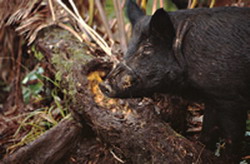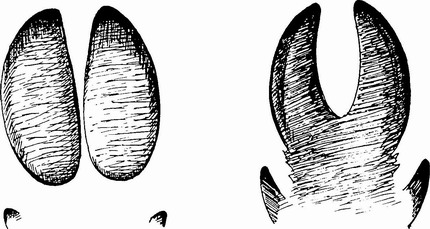
Feral pigs can cause a variety of damage on both a small and large scale. The most common complaint is rooting or grubbing, resulting in the destruction of crops and pastures. Often times, pigs will damage crops immediately after planting or right as grains mature and are ready for harvest. Damage to farm ponds and watering holes for livestock is another common problem, as land contouring and reconstruction is expensive. Predation on domestic stock and wildlife has been a lesser problem in North America, but has been found in some instances.
Tracks of the feral hog (left) and European wild boar (right).
Damage to crops and rangeland by wild pigs is easily identified. Rooting in wet or irrigated soil is generally quite visible, but can vary from an area of several hundred square feet or more to only a few small spots where the ground has been turned over. Rooting destroys pasture, crops, and native plants, and can cause soil erosion.
Wallows are easily seen around ponds and streams and consist of mud or a mud and water mix. In addition, you will often find “rubs” on the trunks of trees in the area of a wallow about 1-2 foot off the ground. Also, pigs love to rub on telephone poles or creosote post. It’s believed that the pigs are attracted to the compound because it naturally repels insects.
Tracks of adult hogs resemble those made by a 200-pound calf. Where ground is soft, dewclaws will show on adult hog tracks
